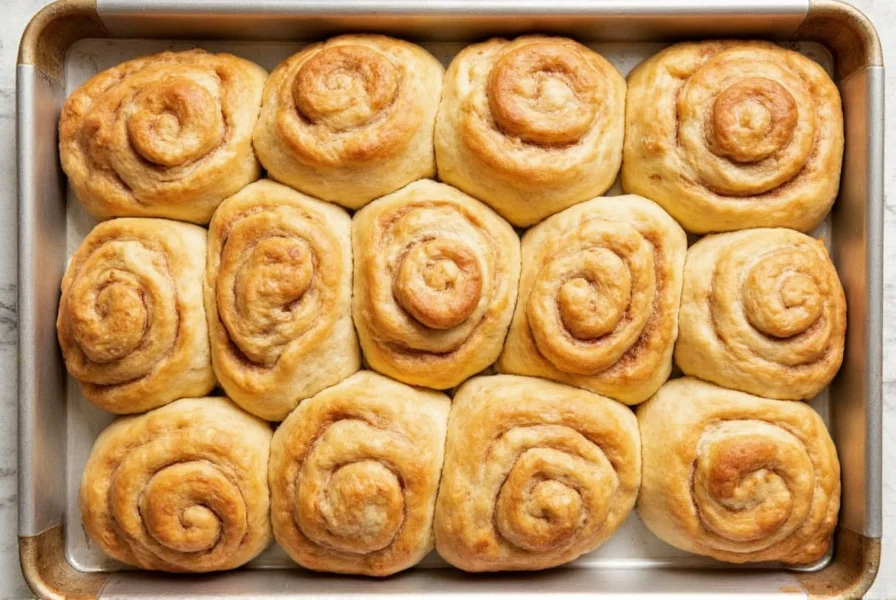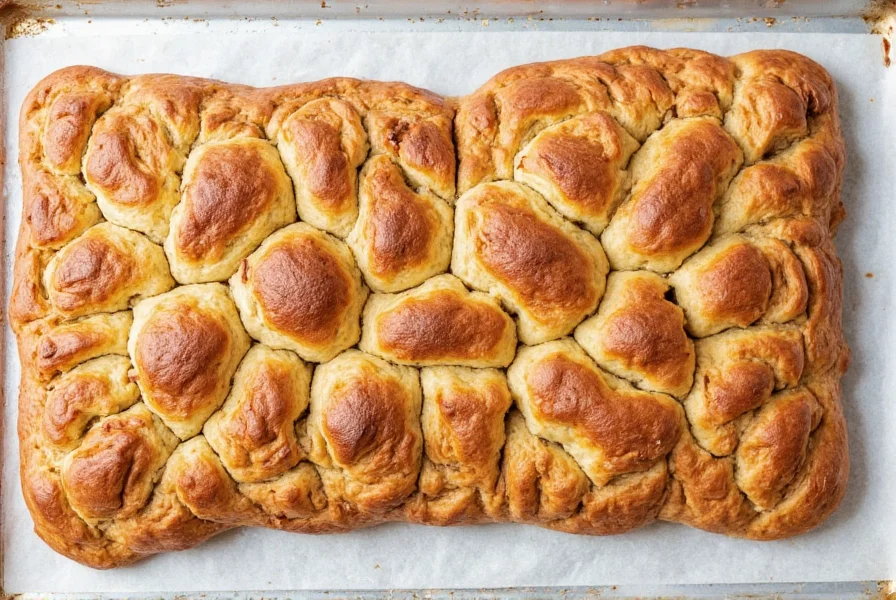If you've ever wondered how to merge two beloved baked goods into one spectacular creation, cinnamon roll focaccia delivers the perfect marriage of Italian bread craftsmanship and American pastry tradition. This innovative recipe has gained popularity among home bakers seeking to elevate their baking repertoire with something uniquely delicious.
Understanding the Cinnamon Roll Focaccia Concept
Cinnamon roll focaccia isn't just cinnamon rolls disguised as flatbread—it's a thoughtful integration of techniques from both baking traditions. Traditional focaccia relies on a high-hydration dough that creates those signature air pockets, while cinnamon rolls use a richer, egg-enriched dough. The magic happens when you adapt focaccia's simplicity with cinnamon roll's sweet filling.
What makes this hybrid special is how it maintains focaccia's characteristic dimpled surface while incorporating the spiral pattern of cinnamon rolls. The result is a pull-apart style bread where each section contains that perfect balance of sweet filling and airy bread structure.
Essential Ingredients for Perfect Cinnamon Roll Focaccia
The beauty of this recipe lies in its approachable ingredients list. You'll need standard focaccia components enhanced with cinnamon roll elements:
| Category | Key Ingredients | Special Purpose |
|---|---|---|
| Dough Base | All-purpose flour, instant yeast, warm water, honey | Creates the foundational structure with subtle sweetness |
| Fat Component | Unsalted butter, olive oil | Butter enriches like cinnamon rolls; olive oil maintains focaccia authenticity |
| Sweet Filling | Brown sugar, cinnamon, melted butter | Creates the signature swirl without overwhelming the bread |
| Finishing Touch | Powdered sugar, milk, vanilla extract | Provides the classic glaze that complements both components |
Step-by-Step Preparation Guide
Creating exceptional cinnamon roll focaccia requires attention to technique. Follow these professional baking steps for best results:
- Dough preparation: Mix 3½ cups flour, 2¼ tsp yeast, 1½ tsp salt, 2 tbsp honey, and 1¼ cups warm water. Knead until smooth (about 8 minutes). Add 3 tbsp olive oil gradually during kneading.
- First rise: Place dough in oiled bowl, cover, and let rise until doubled (60-90 minutes). Proper rising develops flavor and texture.
- Rolling technique: Press risen dough into 12x16 inch rectangle. Brush with melted butter, then evenly sprinkle ½ cup brown sugar mixed with 2 tbsp cinnamon.
- Folding method: Roll dough tightly from long side, then coil into spiral shape in greased 9x13 inch pan. This creates the distinctive pull-apart sections.
- Second rise: Cover and let rise 30-45 minutes until puffy. Don't skip this step—proper proofing ensures light texture.
- Baking: Bake at 375°F (190°C) for 25-30 minutes until golden brown. The internal temperature should reach 190°F (88°C).
- Finishing: Drizzle with glaze made from 1 cup powdered sugar, 2 tbsp milk, and ½ tsp vanilla extract while still warm.
Proven Baking Techniques for Success
Avoid common pitfalls with these expert tips for perfect cinnamon roll focaccia every time:
- Dough hydration matters: Maintain 65-70% hydration for ideal texture—too dry creates tough bread, too wet prevents proper swirling
- Filling distribution: Use a pastry brush to apply melted butter before adding cinnamon-sugar mixture for even adhesion
- Rising environment: Place dough in a slightly warm spot (about 75-80°F) for consistent rising without over-fermenting
- Temperature control: Use an instant-read thermometer to verify internal temperature rather than relying solely on appearance
- Glaze timing: Apply glaze when bread is warm but not hot (about 10 minutes after baking) for perfect absorption without melting
Variations to Elevate Your Cinnamon Roll Focaccia
Once you've mastered the basic recipe, experiment with these creative adaptations:
- Nutty version: Sprinkle chopped pecans or walnuts over the cinnamon-sugar layer before rolling
- Fruity twist: Add thin apple slices or dried cranberries to the filling for complementary flavors
- Spice enhancement: Incorporate ¼ tsp each of nutmeg, cardamom, and allspice into your cinnamon mixture
- Glaze variations: Substitute maple syrup for milk in the glaze, or add orange zest for brightness
- Savory-sweet option: Sprinkle flaky sea salt on top before baking for that popular sweet-salty contrast

Serving and Storage Recommendations
Cinnamon roll focaccia shines as a centerpiece for brunch gatherings or as a special weekend treat. Serve warm for optimal texture and aroma. The pull-apart nature makes it perfect for sharing—simply provide small plates and encourage guests to tear off sections.
For storage, keep in an airtight container at room temperature for up to 2 days. To maintain freshness longer, freeze individual portions in freezer bags for up to 3 months. When reheating, place in a 300°F (150°C) oven for 8-10 minutes to restore that just-baked quality without drying out the bread.
Why This Hybrid Bread Works So Well
The success of cinnamon roll focaccia lies in the complementary textures and flavors of its components. Focaccia's olive oil-infused dough provides a subtle savory base that balances the sweetness of the cinnamon filling. Unlike traditional cinnamon rolls which can be overly rich, this version offers a lighter eating experience while still delivering that satisfying swirl of cinnamon sugar.
Professional bakers appreciate how this recipe bridges cultural baking traditions—honoring Italian bread craftsmanship while embracing American pastry innovation. The result is a versatile baked good that works equally well as a breakfast item, dessert, or even an afternoon snack with coffee.
Frequently Asked Questions
Can I make cinnamon roll focaccia without yeast?
While traditional yeast-based preparation yields the best texture, you can create a quick version using self-rising flour and baking powder. However, the distinctive airy structure and flavor development from yeast fermentation won't be replicated in the no-yeast alternative.
How do I prevent the cinnamon filling from leaking during baking?
To minimize filling leakage, ensure your melted butter is cooled slightly before brushing on the dough, use a moderate amount of filling (don't overpack), and pinch the edges of the rolled dough gently to seal. Chilling the shaped dough for 15 minutes before the final rise also helps set the filling.
What's the ideal thickness for rolling the dough before adding filling?
Roll your dough to approximately ¼-inch thickness before adding the cinnamon filling. This provides enough structure to hold the filling while still allowing the layers to meld properly during baking. Thicker dough may result in undercooked centers, while thinner dough could tear when rolling.
Can I prepare cinnamon roll focaccia ahead of time?
Yes, you can assemble the cinnamon roll focaccia through the shaping step, then cover and refrigerate overnight. The next morning, remove from refrigerator 30 minutes before baking to allow proper rising. This method actually enhances flavor development through slow fermentation.
Why does my cinnamon roll focaccia deflate after baking?
Deflation typically occurs when the dough is over-proofed before baking. The yeast exhausts its food supply, causing the structure to collapse during baking. Aim for dough that springs back slowly when gently pressed—about 75% risen—before placing in the oven.











 浙公网安备
33010002000092号
浙公网安备
33010002000092号 浙B2-20120091-4
浙B2-20120091-4